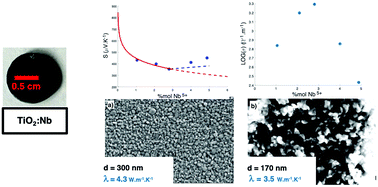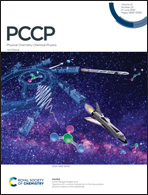Optimum in the thermoelectric efficiency of nanostructured Nb-doped TiO2 ceramics: from polarons to Nb–Nb dimers†
Abstract
Rutile is the most common and stable polymorph form of titanium oxide TiO2 at all temperatures. The doping of rutile TiO2 with a small amount of niobium is reknown for being responsible for a large increase of the electrical conductivity by several orders of magnitude, broadening its technological interest towards new emerging fields such as the thermoelectric conversion of waste heat. The electronic conduction has been found to be of a polaronic nature with strongly localized charges around the Ti3+ centers while, on the other side, the relatively high value of the thermal conductivity implies the existence of lattice heat carriers, i.e. phonons, with large mean free paths which makes the nanostructuration relevant for optimizing the thermoelectric efficiency. Here, the use of a high-pressure and high-temperature sintering technique has allowed to vary the grain size in rutile TiO2 pellets from 300 to 170 nm, leading to a significant reduction of the lattice thermal conductivity. The thermoelectric properties (electrical conductivity, Seebeck coefficient and thermal conductivity) of Nb-doped rutile nanostructured ceramics, namely NbxTi1−xO2 with x varying from 1 to 5%, are reported from room temperature to ∼900 K. With the incorporation of Nb, an optimum in the thermoelectric properties together with an anomaly on the tetragonal lattice constant c are observed for a concentration of ∼2.85%, which might be the fingerprint of the formation of short Nb dimers.



 Please wait while we load your content...
Please wait while we load your content...